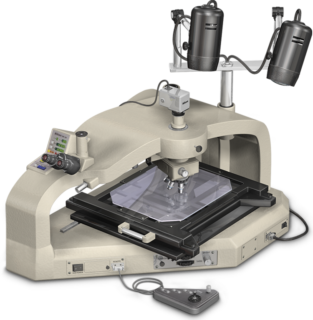Nikon’s Museum of Microscopy
XD-20 Large Substrate Microscope
( early 1990s )
Manufactured in the early 1990s, the XD-20 microscope for large substrate inspection was tailored to fit the needs of thin film transistor color liquid crystal display (LCD) manufacturers. Other uses include semiconductor wafer inspection, circuit board analysis, and examination of a wide spectrum of electronic components.

The microscope has a unique optical system, an oversized stage accommodating substrates up to 470 x 460 millimeters, and boasts thorough anti-contamination countermeasures, ergonomic design, and advanced opto-mechanical features. An arm panel displays important data about the status of various microscope functions, allowing for easy information confirmation without interrupting work.
Many of the automated functions for this microscope include automatic episcopic light intensity control when changing objectives, automated aperture diaphragm adjustments (to 75 percent of the objective's numerical aperture), a motorized nosepiece, and optional autofocusing. A remote keypad allows for control of frequent operations such as nosepiece rotation and episcopic light intensity. A joystick on the keypad controls fine stage movement.
The XD-20 optical system features advanced industrial CF objectives, developed especially for LCD substrates. A 1~3x zoom enlarges images without having to change objectives and, because the nosepiece doesn't have to be rotated, the image can be enlarged without interruption while observing the specimen.
An eyepiece micrometer allows the operator to take measurements with both eyes. A finely divided 0.1-millimeter graticule is built into the first image plane of the relay lens system and can be moved out of the optical path with a slider.
One hundred percent of the light beam can be directed to the additional observation port by the optical path switching lever. This can be used for photographic or closed-circuit television (CCTV) equipment, reducing photographic exposure time and allowing the use of high shutter speeds, even with dark specimens.
One lamp provides both diascopic and episcopic illumination via bifurcated fibers, which assures the same color conditions in both modes. In addition, because the neutral density filters are inserted directly into the illumination unit, changes in brightness do not cause color temperature changes. Colors remain true regardless of light intensity.
Ergonomic features include a low eyepoint for viewing, a convenient data displays on the arm panel, an electric control for coarse movements of the stage, and an optional macro illumination attachment for macro inspections. Contamination is minimized by the distance (540.5 millimeters) between the operator and the objective's optical axis, controlling the microscope via the remote keypad. The microscope is also equipped with shields for moving parts and antistatic paints to combat dust contamination.













